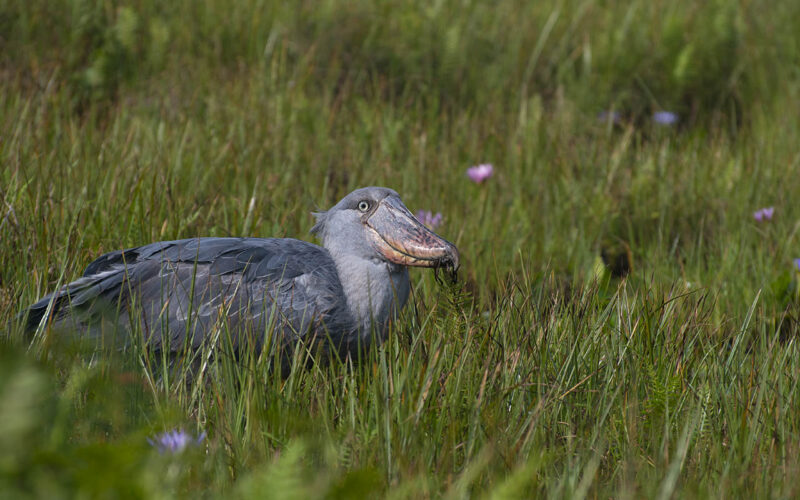Often referred to as a “whale head”, the prehistoric Shoebill (Balaeniceps rex) is a major highlight and a must-see to many visiting birdwatchers on any Uganda birding safari. Standing at about 1.5m tall, the bizarre looking Shoebill derives its name from its over-sized and enormous shoe-like bill. Rare and endangered, the Shoebill is a resident of secluded wetlands and permanent marshes only known from a handful sites in Africa.
Facts about the Shoebill to know
-
Its Prehistoric
The Shoebill is a dinosaur-era species! Earlier studies had placed the Shoebill in the same family as pelicans, but current studies now classify it in a sole family of Balaenicipitidae, a monotypic African family having no near affinities. It’s currently categorized by International Union for Conservation of Nature (IUCN) as endangered species due to pet traders and habitat loss. The Shoebill is named after its oversize and massive straw-colored needle-pointed shoe-like bill, which is a foot long and 5” wide, a distinctive feature that sets out these species. The uniformed grey plumaged giant is a swamp dweller standing at about 1.5m tall and on a buoyant flight it’s wingspan stretches up to eight-feet long. Sexes are similar but males are larger. The Shoebill is considered solitary that even in breeding season, pairs are usually ten to twenty meters apart.
-
Shoebills are slow Breeders
Shoebills are slow breeders taking up to 3yrs between hatchlings and given the fragility of their breeding grounds, the mortality rate and status is considered low. Breeding pairs are monogamous often pairing for life. Pairs construct a massive nest up to 8 feet wide on a strong reed bed where a female lays two to three eggs. After an incubation period of approximately 30 days, fringed brown plumaged hatchlings are hatched and are cared for by both parents. Juveniles produces begging calls like hiccups sounds, attracting parents for food or attention and will attain maturity between 3 to 4 years.

-
A Prolific Hunter
The Shoebill main diet include lungfish, catfish, frogs, young crocodiles, bird chicks and other crustaceans. It stalks less-oxygenated waters, where fish frequently surface to breathe. Its wader-like feet gives it a hunting advantage to stand on perches of floating vegetation. Its been nicknamed a “statue” after its slow and motionless stalking behavior. When prey is spotted, it launches with a lightning speed catching prey with its vise-like mandibles. Shoebills have a hunting success rate of about 60%.
-
Long life
Shoebills in the wild survive up to 35 years while in captivity they have been known to stretch up to 55 years. Being slow-breeders threats include habitat loss by agriculturalists and pet trade hunters.
Where to see the Shoebill during on safari in Uganda
Whereas the Shoebill occur in most extensive and excluded marshes across Uganda, the following hotspots offer high chances to encounter this elusive prehistoric species.
- Mabamba Wetland: Located near Entebbe and Kampala, Mabamba Wetlands offers high chances to see the prehistoric shoebill. The community-run and protected site is part of the extensive wetlands on the northern edges of L. Victoria where hundreds of shoebill occur and breed. Shoebill birding in this expansive Mabamba swamp is by motorized community canoes that explore the interior of the marsh where several dozens of Shoebills occur.
- The Nile Delta in Murchison Falls National Park: The shallow wetlands formed as the Nile pours into Lake Albert is a home and a reknown breeding grounds for the Shoebill. Activity is done on a organized boat safaris to explore this vast papyrus right into the Shoebill home range. The marsh hosts other incredible wetlands specialists.
- Semliki Wildlife Reserve: The expansive wetlands on the southern edges of L. Albert including the Semuliki delta host dozens of shoebill and offers incredible successful sightings.
- Lake Kyoga and Lake Opeta: Inaccessible and remote; the little explored wetlands around Lakes Opeta and Kyoga including the extensive reed floodplains protect a sizeable number of Shoebill and is a reknown breeding strong hold.
